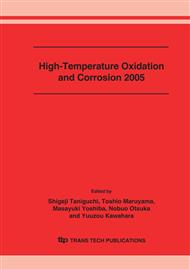p.317
p.323
p.331
p.339
p.345
p.353
p.361
p.369
p.377
In Situ Observation of Failure Behavior for Plasma Sprayed Thermal Barrier Coating Systems under Static Loadings
Abstract:
In situ observation of the mechanical failure behavior was conducted for different kinds of the plasma sprayed thermal barrier coating (TBC) systems by means of an optical microscopy under the static loadings at room and elevated temperatures; as the fundamental aspect, in order to clarify the thermomechanical failure mechanism of TBC system in connection with various coating characteristics. Mechanical tensile or compressive loading was applied progressively to the TBC specimen by an axial loading mode. It was found that the failure behavior of TBC system depends strongly on the testing temperature under both the tensile and compressive loadings. At the elevated temperature which is higher than the ductile-brittle transition temperature (DBTT) of metallic bond-coat (BC), in particular, the ceramic top-coat (TC) spallation can be prevented by virtue of the stress relief induced by the enhanced plastic flow in the BC layer. At the room temperature which is lower than the DBTT of BC, on the contrary, the TC spalling was inevitably induced, but the initiation site of TC spalling is closely related with the magnitude of local plastic deformation in the alloy substrate. Furthermore, an influence of thermally grown oxides (TGO) layer developed at the TC / BC interface on the crack initiation and propagation behavior was investigated in some detail.
Info:
Periodical:
Pages:
345-352
Citation:
Online since:
August 2006
Authors:
Price:
Сopyright:
© 2006 Trans Tech Publications Ltd. All Rights Reserved
Share:
Citation:


